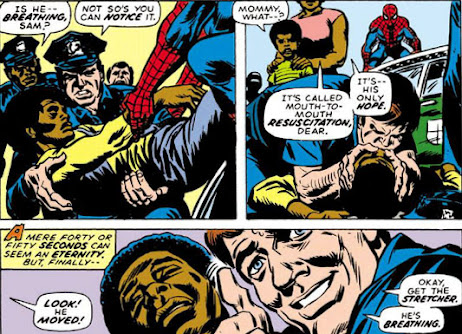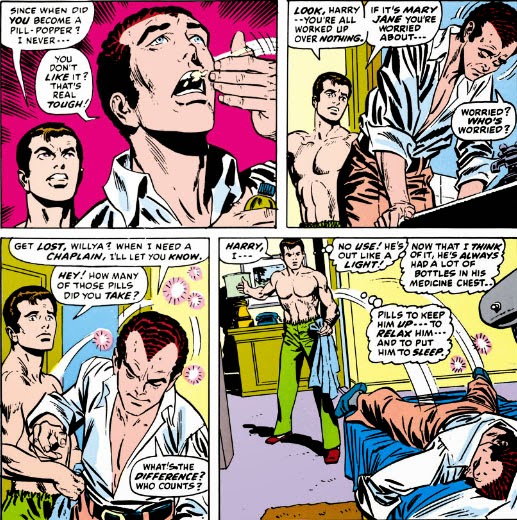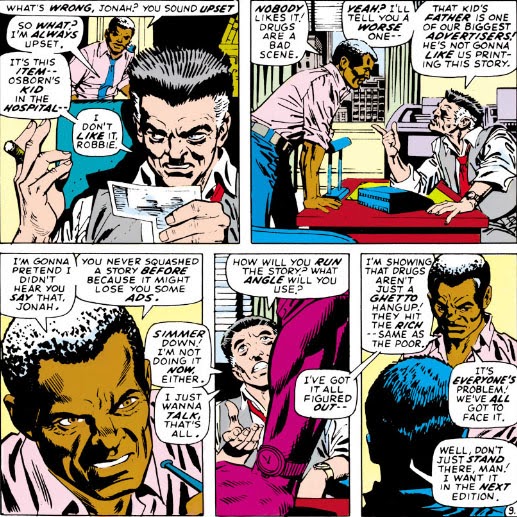Issue #96 of Amazing Spider-Man began a three-part story that's probably known more for its conspicuous absence of the Comics Code stamp on its three covers than it is for its actual story. Written by Stan Lee and pencilled by Gil Kane, the story was declined approval by the Code for depicting drug use, which the Code prohibited even if shown in a negative way. But Lee ran the story anyway, which stemmed from a request by the Nixon administration to have a story on drug abuse featured in one of Marvel's comics.
Lee decides not to hammer home his points about drug use, but rather weave them into what would otherwise be a typical Spider-Man story. There's Mary Jane and Gwen and Harry; there's J. Jonah Jameson and Joe Robertson (along with Joe's son, Randy); there's Aunt May and Anna Watson; and there's of course Peter, who's down in the dumps about practically everything in his life: Gwen deciding to live in England; her hatred of Spider-Man for allegedly causing her father's death; his money situation. There's also Harry's father, Norman, whom Peter still fears may regain his memory of his identity as the Green Goblin, as well as his memory of Spider-Man's true identity. Some of these people Lee will use directly to get his points across--but mostly his mouthpiece will be Peter, who most readers already feel a connection to.
In fact, it's interesting to see to what effect Lee uses both Peter and Harry. Peter, for instance, is adamant about not ever taking drugs--yet, often at the end of his rope financially, his personal life mostly a shambles, and with little prospect for the future, Peter would normally be the type of person who might well get hooked on them. But in Harry, we see a man who is seemingly Peter's opposite, in terms of the hand life has dealt him. Raised with a silver spoon and popular with his friends, he has everything and seems to want for nothing (with the exception of a deeper bond with his father)--but it's Harry who falls prey to the smooth words of a drug dealer and becomes addicted.
But before we get to Harry and Peter, we find Spider-Man heading toward a scene with several policemen, who have responded to news of a possible jumper:
Since Spider-Man is in the area, he manages to catch our guy before it's too late, and deliver him to the police who are standing by:
It's clear that Lee's message here is not only for those who are doing drugs, but also for anyone turning a blind eye to what seems to be an escalating situation. And since this story is going to deal in the Green Goblin later, it only makes sense for Lee to pick Norman Osborn to represent the more affluent yet uninvolved members of society--with Randy Robertson, Robbie's activist son, calling him out.
Randy makes a number of statements I disagree with here--but anger born of frustration will almost always lead to snap judgments, and I doubt that was the impression Lee meant to leave people with. Rather, he seems to want to light a fire under the Osborns of the country--but it's a scene that threatens to take the reader off-track with an unnecessarily confrontational tone. There's a difference between raising an issue vs. shoving it harshly in front of your eyes.
Since this little back-and-forth has given us a glimmer of the Goblin peeking out from Osborn's eyes, let's shift our attention to his son, Harry, who has the dubious pleasure of dating Mary Jane Watson. Mary Jane is something of a player at this point in time, making obvious overtures toward Peter even within eyesight of the guy she's going out with. To her, Harry is something of a prop--someone to string along while he provides access to Peter for her. At first, his way of dealing with his rejection is by way of the pharmacy:
But when a dealer spots his difficulties, he supplements his little regimen with hard drugs:
Peter, though, finds him just in time, and sees him to the hospital:
As luck would have it, Peter bumps into Harry's dealer, who makes the mistake of trying to enlist Peter as his message boy:
Hoo-boy. I think we can all agree that the dealer has "tweee'd" himself into a world of trouble here. But Peter isn't about to deprive himself of the satisfaction of wasting this crew:
While these guys scrape themselves off the ground, we should also check in with Jonah Jameson, who's consulting with his editor about a story they're preparing to run on Harry Osborn's drug-induced hospital stay:
It's scenes like this that tend to stand out above Jameson's usual antics and his incessant vendetta against Spider-Man. Jameson and Robertson, when immersed in their roles as newsmen, make you appreciate not only the seasoned reporting of The Daily Bugle but also often offer some of the most compelling scenes in this book. Robbie and Jameson, on the surface, seem like polar opposites in terms of their professional detachment--but a good story settles all differences between them. Jameson knows what he's got in Robbie, and the two work together in near-perfect sync when the paper's reputation is at stake. In my opinion they're two of the better characters that Lee has created.
It's actually Harry's status as a patient that allows Spidey to finally deal with the Goblin--and Peter even gets a happy ending when Gwen returns from England to be with him. Lee arguably struck a reasonable balance between the threat of the Goblin and raising drug awareness with readers--awareness that, thanks to the publicity generated by the Code's decision, was probably helped in the end.


















No comments:
Post a Comment